Report on 505 - Person-Centred Practice for Positive Outcomes in Care
VerifiedAdded on 2023/06/18
|19
|6698
|440
Report
AI Summary
This report delves into person-centred practice and its impact on achieving positive outcomes in healthcare settings. It examines the theoretical underpinnings, including the Building Block framework and the Seven P’s, emphasizing the importance of placing the individual at the centre of care. The report discusses strategies for fostering an organizational culture that values positive outcomes and person-centred approaches, including self-acceptance, positive relationships, and employee training. It addresses the management of changing needs, resource allocation, and the implementation of healthy choices, highlighting the significance of feedback and effective record-keeping. Furthermore, the report explores management systems for early identification of health and care needs, the implementation of safe health practices, and the promotion of active participation in daily activities. The importance of maintaining health records in line with legislation and organizational requirements is also emphasized. Desklib provides access to this and other solved assignments for students.
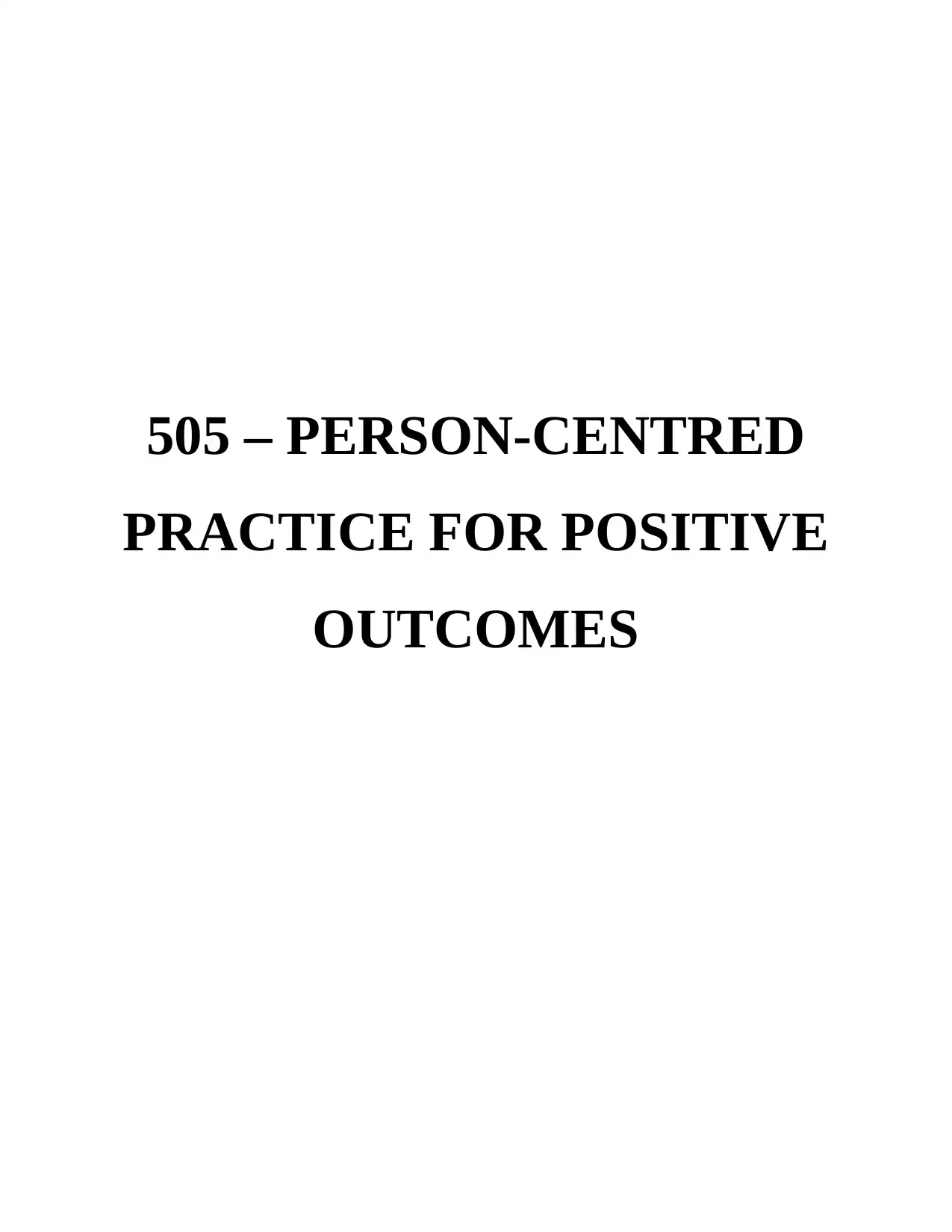
505 – PERSON-CENTRED
PRACTICE FOR POSITIVE
OUTCOMES
PRACTICE FOR POSITIVE
OUTCOMES
Paraphrase This Document
Need a fresh take? Get an instant paraphrase of this document with our AI Paraphraser
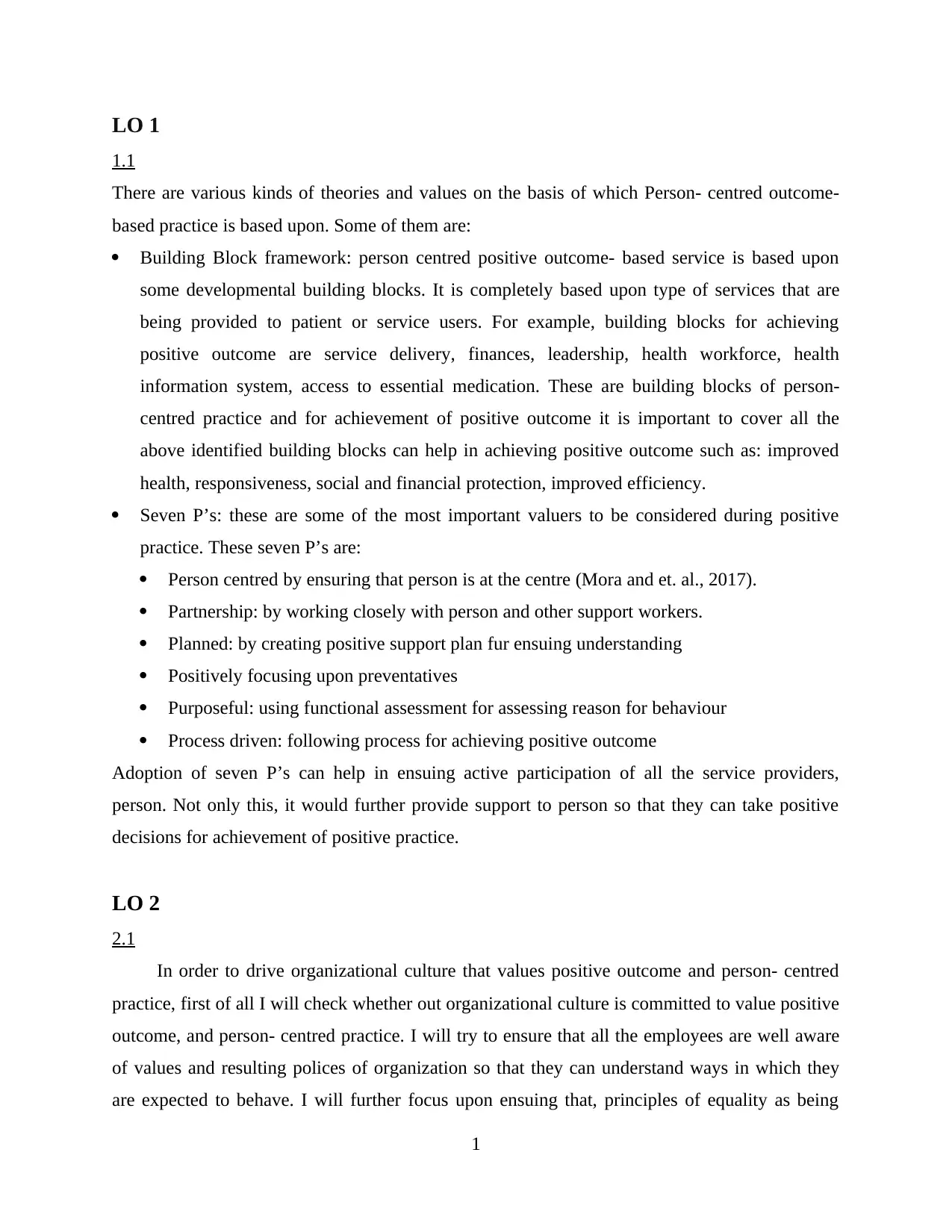
LO 1
1.1
There are various kinds of theories and values on the basis of which Person- centred outcome-
based practice is based upon. Some of them are:
Building Block framework: person centred positive outcome- based service is based upon
some developmental building blocks. It is completely based upon type of services that are
being provided to patient or service users. For example, building blocks for achieving
positive outcome are service delivery, finances, leadership, health workforce, health
information system, access to essential medication. These are building blocks of person-
centred practice and for achievement of positive outcome it is important to cover all the
above identified building blocks can help in achieving positive outcome such as: improved
health, responsiveness, social and financial protection, improved efficiency.
Seven P’s: these are some of the most important valuers to be considered during positive
practice. These seven P’s are:
Person centred by ensuring that person is at the centre (Mora and et. al., 2017).
Partnership: by working closely with person and other support workers.
Planned: by creating positive support plan fur ensuing understanding
Positively focusing upon preventatives
Purposeful: using functional assessment for assessing reason for behaviour
Process driven: following process for achieving positive outcome
Adoption of seven P’s can help in ensuing active participation of all the service providers,
person. Not only this, it would further provide support to person so that they can take positive
decisions for achievement of positive practice.
LO 2
2.1
In order to drive organizational culture that values positive outcome and person- centred
practice, first of all I will check whether out organizational culture is committed to value positive
outcome, and person- centred practice. I will try to ensure that all the employees are well aware
of values and resulting polices of organization so that they can understand ways in which they
are expected to behave. I will further focus upon ensuing that, principles of equality as being
1
1.1
There are various kinds of theories and values on the basis of which Person- centred outcome-
based practice is based upon. Some of them are:
Building Block framework: person centred positive outcome- based service is based upon
some developmental building blocks. It is completely based upon type of services that are
being provided to patient or service users. For example, building blocks for achieving
positive outcome are service delivery, finances, leadership, health workforce, health
information system, access to essential medication. These are building blocks of person-
centred practice and for achievement of positive outcome it is important to cover all the
above identified building blocks can help in achieving positive outcome such as: improved
health, responsiveness, social and financial protection, improved efficiency.
Seven P’s: these are some of the most important valuers to be considered during positive
practice. These seven P’s are:
Person centred by ensuring that person is at the centre (Mora and et. al., 2017).
Partnership: by working closely with person and other support workers.
Planned: by creating positive support plan fur ensuing understanding
Positively focusing upon preventatives
Purposeful: using functional assessment for assessing reason for behaviour
Process driven: following process for achieving positive outcome
Adoption of seven P’s can help in ensuing active participation of all the service providers,
person. Not only this, it would further provide support to person so that they can take positive
decisions for achievement of positive practice.
LO 2
2.1
In order to drive organizational culture that values positive outcome and person- centred
practice, first of all I will check whether out organizational culture is committed to value positive
outcome, and person- centred practice. I will try to ensure that all the employees are well aware
of values and resulting polices of organization so that they can understand ways in which they
are expected to behave. I will further focus upon ensuing that, principles of equality as being
1
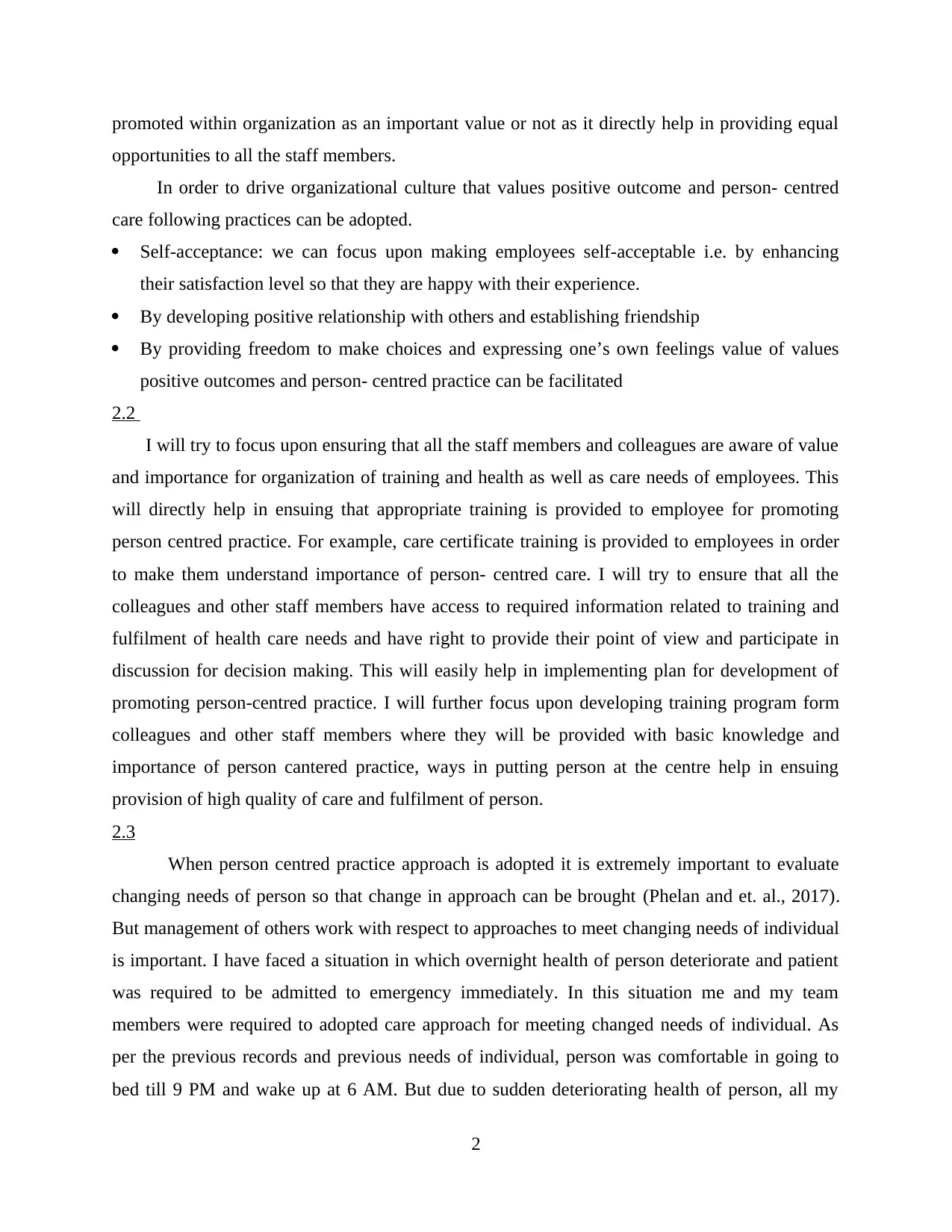
promoted within organization as an important value or not as it directly help in providing equal
opportunities to all the staff members.
In order to drive organizational culture that values positive outcome and person- centred
care following practices can be adopted.
Self-acceptance: we can focus upon making employees self-acceptable i.e. by enhancing
their satisfaction level so that they are happy with their experience.
By developing positive relationship with others and establishing friendship
By providing freedom to make choices and expressing one’s own feelings value of values
positive outcomes and person- centred practice can be facilitated
2.2
I will try to focus upon ensuring that all the staff members and colleagues are aware of value
and importance for organization of training and health as well as care needs of employees. This
will directly help in ensuing that appropriate training is provided to employee for promoting
person centred practice. For example, care certificate training is provided to employees in order
to make them understand importance of person- centred care. I will try to ensure that all the
colleagues and other staff members have access to required information related to training and
fulfilment of health care needs and have right to provide their point of view and participate in
discussion for decision making. This will easily help in implementing plan for development of
promoting person-centred practice. I will further focus upon developing training program form
colleagues and other staff members where they will be provided with basic knowledge and
importance of person cantered practice, ways in putting person at the centre help in ensuing
provision of high quality of care and fulfilment of person.
2.3
When person centred practice approach is adopted it is extremely important to evaluate
changing needs of person so that change in approach can be brought (Phelan and et. al., 2017).
But management of others work with respect to approaches to meet changing needs of individual
is important. I have faced a situation in which overnight health of person deteriorate and patient
was required to be admitted to emergency immediately. In this situation me and my team
members were required to adopted care approach for meeting changed needs of individual. As
per the previous records and previous needs of individual, person was comfortable in going to
bed till 9 PM and wake up at 6 AM. But due to sudden deteriorating health of person, all my
2
opportunities to all the staff members.
In order to drive organizational culture that values positive outcome and person- centred
care following practices can be adopted.
Self-acceptance: we can focus upon making employees self-acceptable i.e. by enhancing
their satisfaction level so that they are happy with their experience.
By developing positive relationship with others and establishing friendship
By providing freedom to make choices and expressing one’s own feelings value of values
positive outcomes and person- centred practice can be facilitated
2.2
I will try to focus upon ensuring that all the staff members and colleagues are aware of value
and importance for organization of training and health as well as care needs of employees. This
will directly help in ensuing that appropriate training is provided to employee for promoting
person centred practice. For example, care certificate training is provided to employees in order
to make them understand importance of person- centred care. I will try to ensure that all the
colleagues and other staff members have access to required information related to training and
fulfilment of health care needs and have right to provide their point of view and participate in
discussion for decision making. This will easily help in implementing plan for development of
promoting person-centred practice. I will further focus upon developing training program form
colleagues and other staff members where they will be provided with basic knowledge and
importance of person cantered practice, ways in putting person at the centre help in ensuing
provision of high quality of care and fulfilment of person.
2.3
When person centred practice approach is adopted it is extremely important to evaluate
changing needs of person so that change in approach can be brought (Phelan and et. al., 2017).
But management of others work with respect to approaches to meet changing needs of individual
is important. I have faced a situation in which overnight health of person deteriorate and patient
was required to be admitted to emergency immediately. In this situation me and my team
members were required to adopted care approach for meeting changed needs of individual. As
per the previous records and previous needs of individual, person was comfortable in going to
bed till 9 PM and wake up at 6 AM. But due to sudden deteriorating health of person, all my
2
⊘ This is a preview!⊘
Do you want full access?
Subscribe today to unlock all pages.

Trusted by 1+ million students worldwide
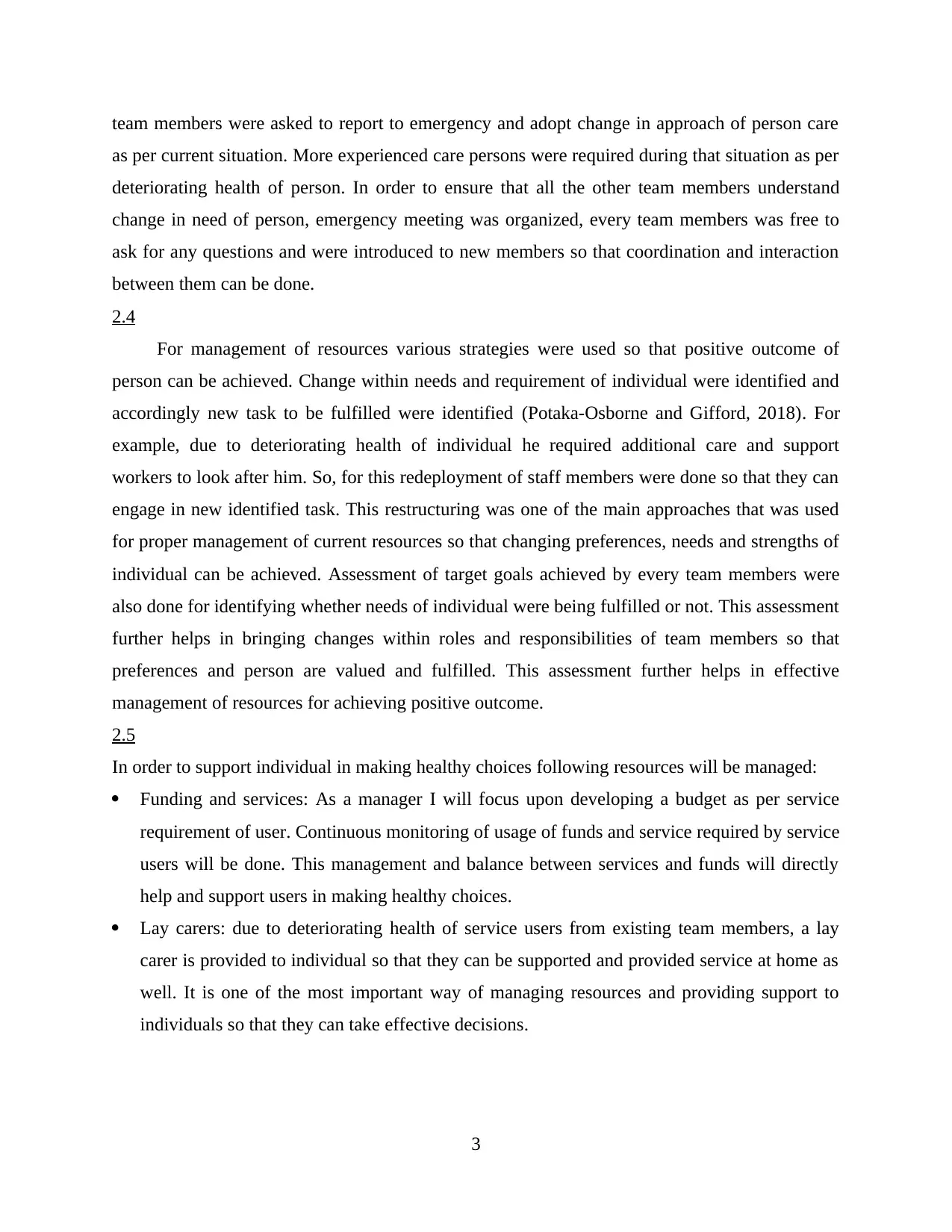
team members were asked to report to emergency and adopt change in approach of person care
as per current situation. More experienced care persons were required during that situation as per
deteriorating health of person. In order to ensure that all the other team members understand
change in need of person, emergency meeting was organized, every team members was free to
ask for any questions and were introduced to new members so that coordination and interaction
between them can be done.
2.4
For management of resources various strategies were used so that positive outcome of
person can be achieved. Change within needs and requirement of individual were identified and
accordingly new task to be fulfilled were identified (Potaka-Osborne and Gifford, 2018). For
example, due to deteriorating health of individual he required additional care and support
workers to look after him. So, for this redeployment of staff members were done so that they can
engage in new identified task. This restructuring was one of the main approaches that was used
for proper management of current resources so that changing preferences, needs and strengths of
individual can be achieved. Assessment of target goals achieved by every team members were
also done for identifying whether needs of individual were being fulfilled or not. This assessment
further helps in bringing changes within roles and responsibilities of team members so that
preferences and person are valued and fulfilled. This assessment further helps in effective
management of resources for achieving positive outcome.
2.5
In order to support individual in making healthy choices following resources will be managed:
Funding and services: As a manager I will focus upon developing a budget as per service
requirement of user. Continuous monitoring of usage of funds and service required by service
users will be done. This management and balance between services and funds will directly
help and support users in making healthy choices.
Lay carers: due to deteriorating health of service users from existing team members, a lay
carer is provided to individual so that they can be supported and provided service at home as
well. It is one of the most important way of managing resources and providing support to
individuals so that they can take effective decisions.
3
as per current situation. More experienced care persons were required during that situation as per
deteriorating health of person. In order to ensure that all the other team members understand
change in need of person, emergency meeting was organized, every team members was free to
ask for any questions and were introduced to new members so that coordination and interaction
between them can be done.
2.4
For management of resources various strategies were used so that positive outcome of
person can be achieved. Change within needs and requirement of individual were identified and
accordingly new task to be fulfilled were identified (Potaka-Osborne and Gifford, 2018). For
example, due to deteriorating health of individual he required additional care and support
workers to look after him. So, for this redeployment of staff members were done so that they can
engage in new identified task. This restructuring was one of the main approaches that was used
for proper management of current resources so that changing preferences, needs and strengths of
individual can be achieved. Assessment of target goals achieved by every team members were
also done for identifying whether needs of individual were being fulfilled or not. This assessment
further helps in bringing changes within roles and responsibilities of team members so that
preferences and person are valued and fulfilled. This assessment further helps in effective
management of resources for achieving positive outcome.
2.5
In order to support individual in making healthy choices following resources will be managed:
Funding and services: As a manager I will focus upon developing a budget as per service
requirement of user. Continuous monitoring of usage of funds and service required by service
users will be done. This management and balance between services and funds will directly
help and support users in making healthy choices.
Lay carers: due to deteriorating health of service users from existing team members, a lay
carer is provided to individual so that they can be supported and provided service at home as
well. It is one of the most important way of managing resources and providing support to
individuals so that they can take effective decisions.
3
Paraphrase This Document
Need a fresh take? Get an instant paraphrase of this document with our AI Paraphraser
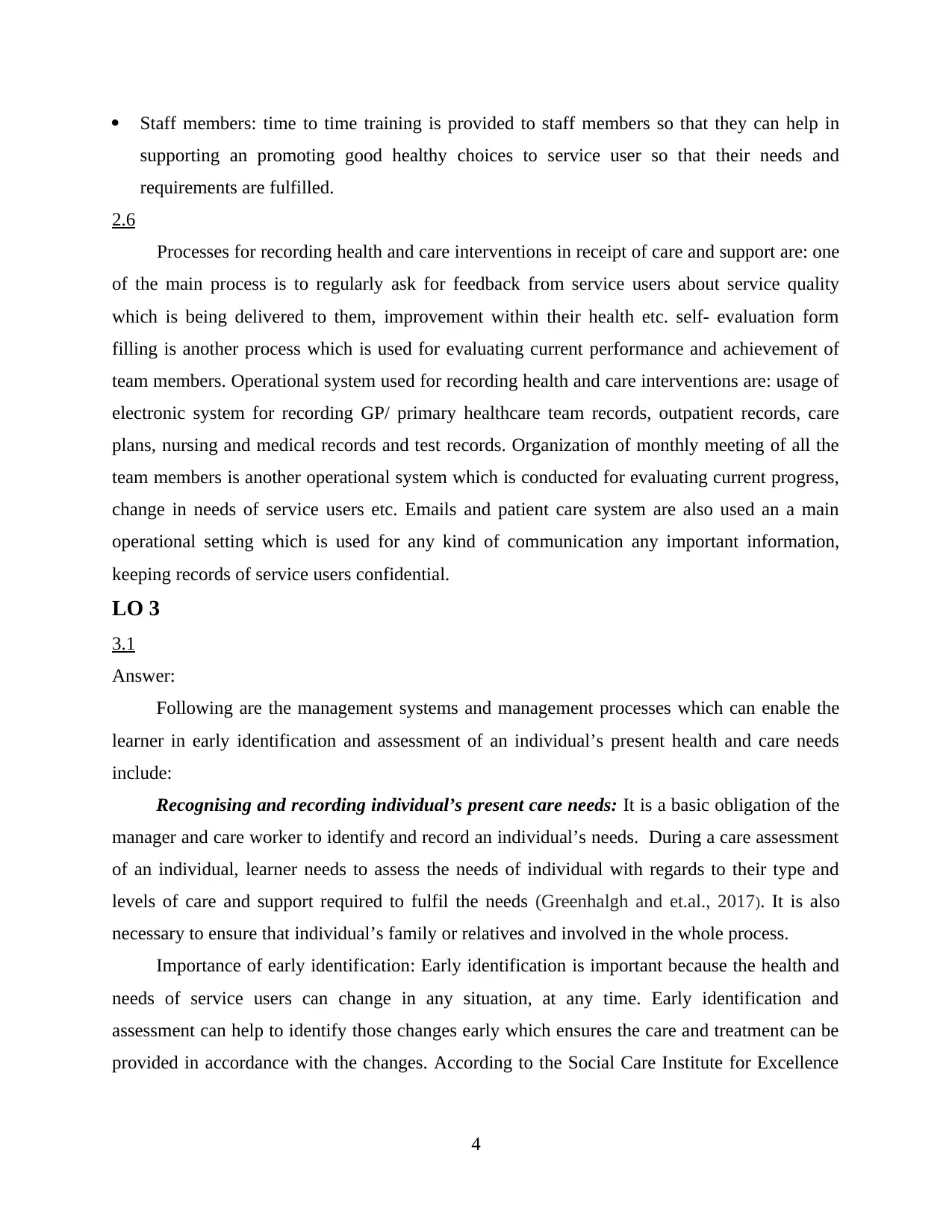
Staff members: time to time training is provided to staff members so that they can help in
supporting an promoting good healthy choices to service user so that their needs and
requirements are fulfilled.
2.6
Processes for recording health and care interventions in receipt of care and support are: one
of the main process is to regularly ask for feedback from service users about service quality
which is being delivered to them, improvement within their health etc. self- evaluation form
filling is another process which is used for evaluating current performance and achievement of
team members. Operational system used for recording health and care interventions are: usage of
electronic system for recording GP/ primary healthcare team records, outpatient records, care
plans, nursing and medical records and test records. Organization of monthly meeting of all the
team members is another operational system which is conducted for evaluating current progress,
change in needs of service users etc. Emails and patient care system are also used an a main
operational setting which is used for any kind of communication any important information,
keeping records of service users confidential.
LO 3
3.1
Answer:
Following are the management systems and management processes which can enable the
learner in early identification and assessment of an individual’s present health and care needs
include:
Recognising and recording individual’s present care needs: It is a basic obligation of the
manager and care worker to identify and record an individual’s needs. During a care assessment
of an individual, learner needs to assess the needs of individual with regards to their type and
levels of care and support required to fulfil the needs (Greenhalgh and et.al., 2017). It is also
necessary to ensure that individual’s family or relatives and involved in the whole process.
Importance of early identification: Early identification is important because the health and
needs of service users can change in any situation, at any time. Early identification and
assessment can help to identify those changes early which ensures the care and treatment can be
provided in accordance with the changes. According to the Social Care Institute for Excellence
4
supporting an promoting good healthy choices to service user so that their needs and
requirements are fulfilled.
2.6
Processes for recording health and care interventions in receipt of care and support are: one
of the main process is to regularly ask for feedback from service users about service quality
which is being delivered to them, improvement within their health etc. self- evaluation form
filling is another process which is used for evaluating current performance and achievement of
team members. Operational system used for recording health and care interventions are: usage of
electronic system for recording GP/ primary healthcare team records, outpatient records, care
plans, nursing and medical records and test records. Organization of monthly meeting of all the
team members is another operational system which is conducted for evaluating current progress,
change in needs of service users etc. Emails and patient care system are also used an a main
operational setting which is used for any kind of communication any important information,
keeping records of service users confidential.
LO 3
3.1
Answer:
Following are the management systems and management processes which can enable the
learner in early identification and assessment of an individual’s present health and care needs
include:
Recognising and recording individual’s present care needs: It is a basic obligation of the
manager and care worker to identify and record an individual’s needs. During a care assessment
of an individual, learner needs to assess the needs of individual with regards to their type and
levels of care and support required to fulfil the needs (Greenhalgh and et.al., 2017). It is also
necessary to ensure that individual’s family or relatives and involved in the whole process.
Importance of early identification: Early identification is important because the health and
needs of service users can change in any situation, at any time. Early identification and
assessment can help to identify those changes early which ensures the care and treatment can be
provided in accordance with the changes. According to the Social Care Institute for Excellence
4
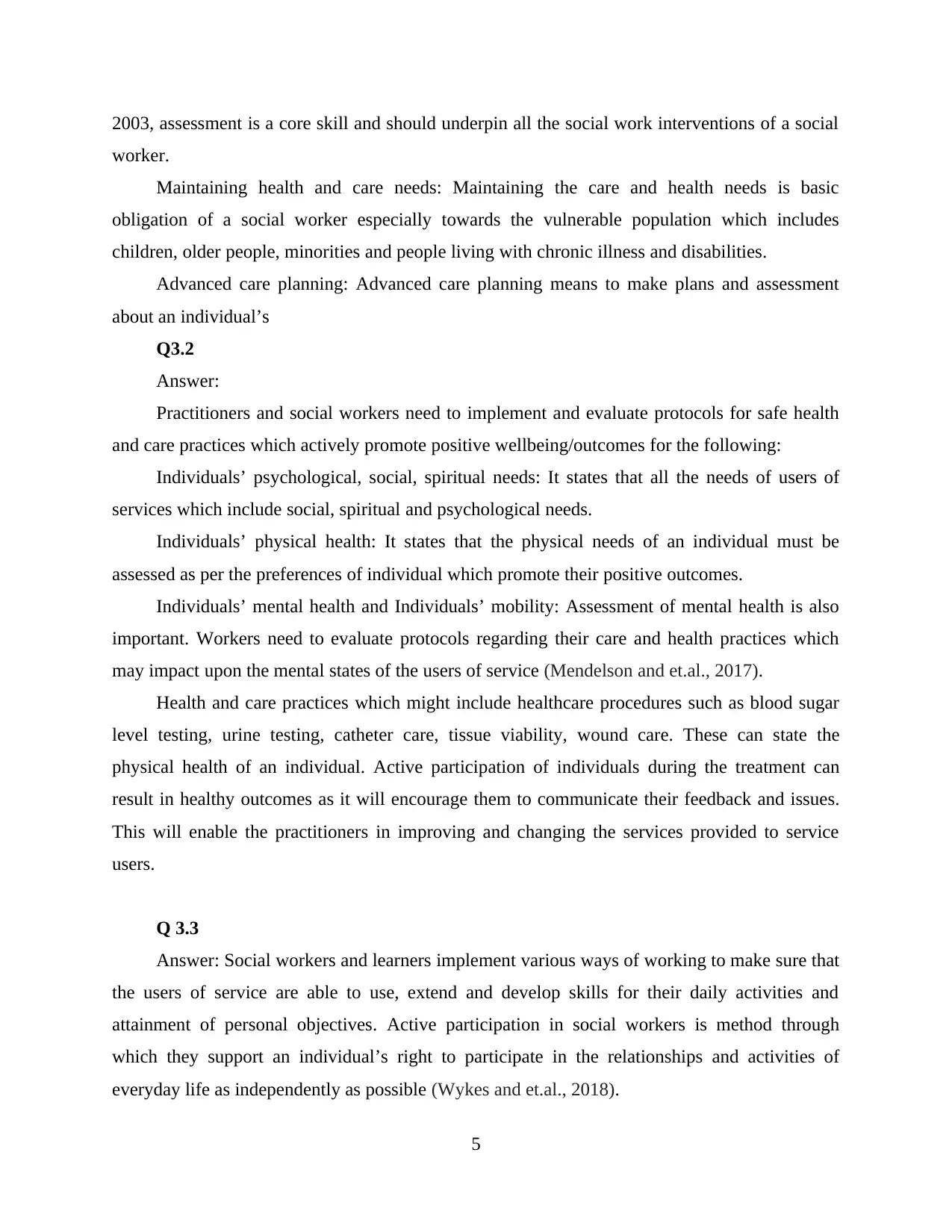
2003, assessment is a core skill and should underpin all the social work interventions of a social
worker.
Maintaining health and care needs: Maintaining the care and health needs is basic
obligation of a social worker especially towards the vulnerable population which includes
children, older people, minorities and people living with chronic illness and disabilities.
Advanced care planning: Advanced care planning means to make plans and assessment
about an individual’s
Q3.2
Answer:
Practitioners and social workers need to implement and evaluate protocols for safe health
and care practices which actively promote positive wellbeing/outcomes for the following:
Individuals’ psychological, social, spiritual needs: It states that all the needs of users of
services which include social, spiritual and psychological needs.
Individuals’ physical health: It states that the physical needs of an individual must be
assessed as per the preferences of individual which promote their positive outcomes.
Individuals’ mental health and Individuals’ mobility: Assessment of mental health is also
important. Workers need to evaluate protocols regarding their care and health practices which
may impact upon the mental states of the users of service (Mendelson and et.al., 2017).
Health and care practices which might include healthcare procedures such as blood sugar
level testing, urine testing, catheter care, tissue viability, wound care. These can state the
physical health of an individual. Active participation of individuals during the treatment can
result in healthy outcomes as it will encourage them to communicate their feedback and issues.
This will enable the practitioners in improving and changing the services provided to service
users.
Q 3.3
Answer: Social workers and learners implement various ways of working to make sure that
the users of service are able to use, extend and develop skills for their daily activities and
attainment of personal objectives. Active participation in social workers is method through
which they support an individual’s right to participate in the relationships and activities of
everyday life as independently as possible (Wykes and et.al., 2018).
5
worker.
Maintaining health and care needs: Maintaining the care and health needs is basic
obligation of a social worker especially towards the vulnerable population which includes
children, older people, minorities and people living with chronic illness and disabilities.
Advanced care planning: Advanced care planning means to make plans and assessment
about an individual’s
Q3.2
Answer:
Practitioners and social workers need to implement and evaluate protocols for safe health
and care practices which actively promote positive wellbeing/outcomes for the following:
Individuals’ psychological, social, spiritual needs: It states that all the needs of users of
services which include social, spiritual and psychological needs.
Individuals’ physical health: It states that the physical needs of an individual must be
assessed as per the preferences of individual which promote their positive outcomes.
Individuals’ mental health and Individuals’ mobility: Assessment of mental health is also
important. Workers need to evaluate protocols regarding their care and health practices which
may impact upon the mental states of the users of service (Mendelson and et.al., 2017).
Health and care practices which might include healthcare procedures such as blood sugar
level testing, urine testing, catheter care, tissue viability, wound care. These can state the
physical health of an individual. Active participation of individuals during the treatment can
result in healthy outcomes as it will encourage them to communicate their feedback and issues.
This will enable the practitioners in improving and changing the services provided to service
users.
Q 3.3
Answer: Social workers and learners implement various ways of working to make sure that
the users of service are able to use, extend and develop skills for their daily activities and
attainment of personal objectives. Active participation in social workers is method through
which they support an individual’s right to participate in the relationships and activities of
everyday life as independently as possible (Wykes and et.al., 2018).
5
⊘ This is a preview!⊘
Do you want full access?
Subscribe today to unlock all pages.

Trusted by 1+ million students worldwide
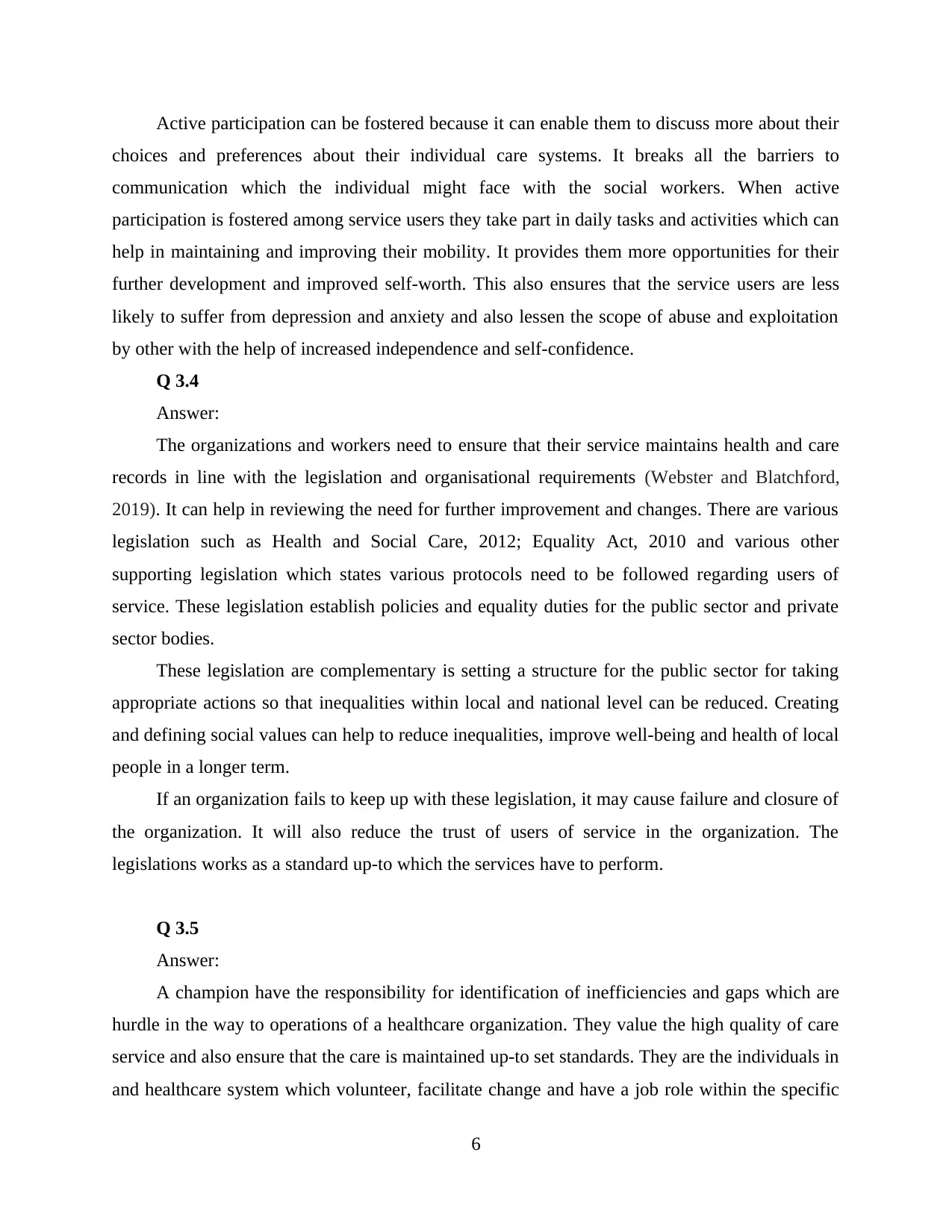
Active participation can be fostered because it can enable them to discuss more about their
choices and preferences about their individual care systems. It breaks all the barriers to
communication which the individual might face with the social workers. When active
participation is fostered among service users they take part in daily tasks and activities which can
help in maintaining and improving their mobility. It provides them more opportunities for their
further development and improved self-worth. This also ensures that the service users are less
likely to suffer from depression and anxiety and also lessen the scope of abuse and exploitation
by other with the help of increased independence and self-confidence.
Q 3.4
Answer:
The organizations and workers need to ensure that their service maintains health and care
records in line with the legislation and organisational requirements (Webster and Blatchford,
2019). It can help in reviewing the need for further improvement and changes. There are various
legislation such as Health and Social Care, 2012; Equality Act, 2010 and various other
supporting legislation which states various protocols need to be followed regarding users of
service. These legislation establish policies and equality duties for the public sector and private
sector bodies.
These legislation are complementary is setting a structure for the public sector for taking
appropriate actions so that inequalities within local and national level can be reduced. Creating
and defining social values can help to reduce inequalities, improve well-being and health of local
people in a longer term.
If an organization fails to keep up with these legislation, it may cause failure and closure of
the organization. It will also reduce the trust of users of service in the organization. The
legislations works as a standard up-to which the services have to perform.
Q 3.5
Answer:
A champion have the responsibility for identification of inefficiencies and gaps which are
hurdle in the way to operations of a healthcare organization. They value the high quality of care
service and also ensure that the care is maintained up-to set standards. They are the individuals in
and healthcare system which volunteer, facilitate change and have a job role within the specific
6
choices and preferences about their individual care systems. It breaks all the barriers to
communication which the individual might face with the social workers. When active
participation is fostered among service users they take part in daily tasks and activities which can
help in maintaining and improving their mobility. It provides them more opportunities for their
further development and improved self-worth. This also ensures that the service users are less
likely to suffer from depression and anxiety and also lessen the scope of abuse and exploitation
by other with the help of increased independence and self-confidence.
Q 3.4
Answer:
The organizations and workers need to ensure that their service maintains health and care
records in line with the legislation and organisational requirements (Webster and Blatchford,
2019). It can help in reviewing the need for further improvement and changes. There are various
legislation such as Health and Social Care, 2012; Equality Act, 2010 and various other
supporting legislation which states various protocols need to be followed regarding users of
service. These legislation establish policies and equality duties for the public sector and private
sector bodies.
These legislation are complementary is setting a structure for the public sector for taking
appropriate actions so that inequalities within local and national level can be reduced. Creating
and defining social values can help to reduce inequalities, improve well-being and health of local
people in a longer term.
If an organization fails to keep up with these legislation, it may cause failure and closure of
the organization. It will also reduce the trust of users of service in the organization. The
legislations works as a standard up-to which the services have to perform.
Q 3.5
Answer:
A champion have the responsibility for identification of inefficiencies and gaps which are
hurdle in the way to operations of a healthcare organization. They value the high quality of care
service and also ensure that the care is maintained up-to set standards. They are the individuals in
and healthcare system which volunteer, facilitate change and have a job role within the specific
6
Paraphrase This Document
Need a fresh take? Get an instant paraphrase of this document with our AI Paraphraser
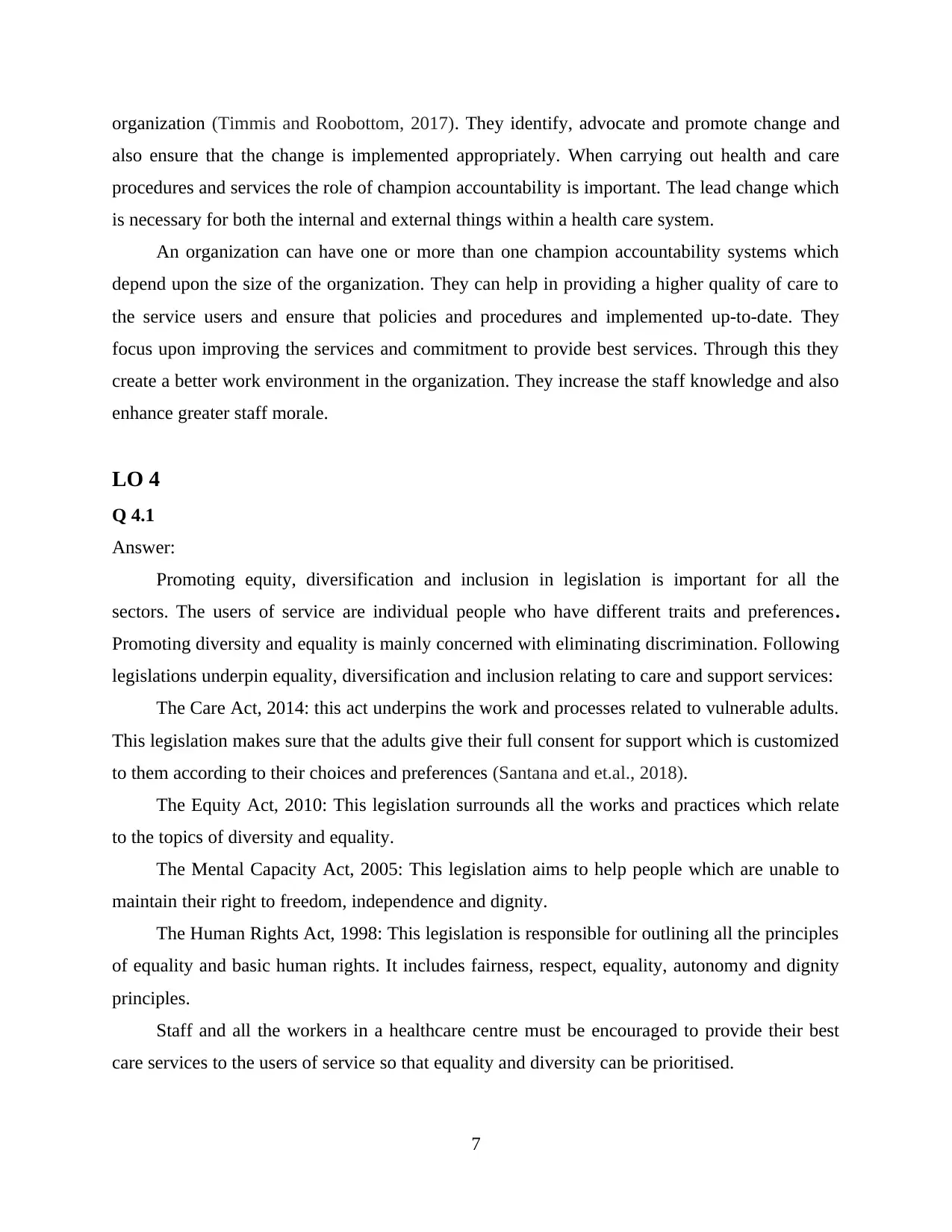
organization (Timmis and Roobottom, 2017). They identify, advocate and promote change and
also ensure that the change is implemented appropriately. When carrying out health and care
procedures and services the role of champion accountability is important. The lead change which
is necessary for both the internal and external things within a health care system.
An organization can have one or more than one champion accountability systems which
depend upon the size of the organization. They can help in providing a higher quality of care to
the service users and ensure that policies and procedures and implemented up-to-date. They
focus upon improving the services and commitment to provide best services. Through this they
create a better work environment in the organization. They increase the staff knowledge and also
enhance greater staff morale.
LO 4
Q 4.1
Answer:
Promoting equity, diversification and inclusion in legislation is important for all the
sectors. The users of service are individual people who have different traits and preferences.
Promoting diversity and equality is mainly concerned with eliminating discrimination. Following
legislations underpin equality, diversification and inclusion relating to care and support services:
The Care Act, 2014: this act underpins the work and processes related to vulnerable adults.
This legislation makes sure that the adults give their full consent for support which is customized
to them according to their choices and preferences (Santana and et.al., 2018).
The Equity Act, 2010: This legislation surrounds all the works and practices which relate
to the topics of diversity and equality.
The Mental Capacity Act, 2005: This legislation aims to help people which are unable to
maintain their right to freedom, independence and dignity.
The Human Rights Act, 1998: This legislation is responsible for outlining all the principles
of equality and basic human rights. It includes fairness, respect, equality, autonomy and dignity
principles.
Staff and all the workers in a healthcare centre must be encouraged to provide their best
care services to the users of service so that equality and diversity can be prioritised.
7
also ensure that the change is implemented appropriately. When carrying out health and care
procedures and services the role of champion accountability is important. The lead change which
is necessary for both the internal and external things within a health care system.
An organization can have one or more than one champion accountability systems which
depend upon the size of the organization. They can help in providing a higher quality of care to
the service users and ensure that policies and procedures and implemented up-to-date. They
focus upon improving the services and commitment to provide best services. Through this they
create a better work environment in the organization. They increase the staff knowledge and also
enhance greater staff morale.
LO 4
Q 4.1
Answer:
Promoting equity, diversification and inclusion in legislation is important for all the
sectors. The users of service are individual people who have different traits and preferences.
Promoting diversity and equality is mainly concerned with eliminating discrimination. Following
legislations underpin equality, diversification and inclusion relating to care and support services:
The Care Act, 2014: this act underpins the work and processes related to vulnerable adults.
This legislation makes sure that the adults give their full consent for support which is customized
to them according to their choices and preferences (Santana and et.al., 2018).
The Equity Act, 2010: This legislation surrounds all the works and practices which relate
to the topics of diversity and equality.
The Mental Capacity Act, 2005: This legislation aims to help people which are unable to
maintain their right to freedom, independence and dignity.
The Human Rights Act, 1998: This legislation is responsible for outlining all the principles
of equality and basic human rights. It includes fairness, respect, equality, autonomy and dignity
principles.
Staff and all the workers in a healthcare centre must be encouraged to provide their best
care services to the users of service so that equality and diversity can be prioritised.
7
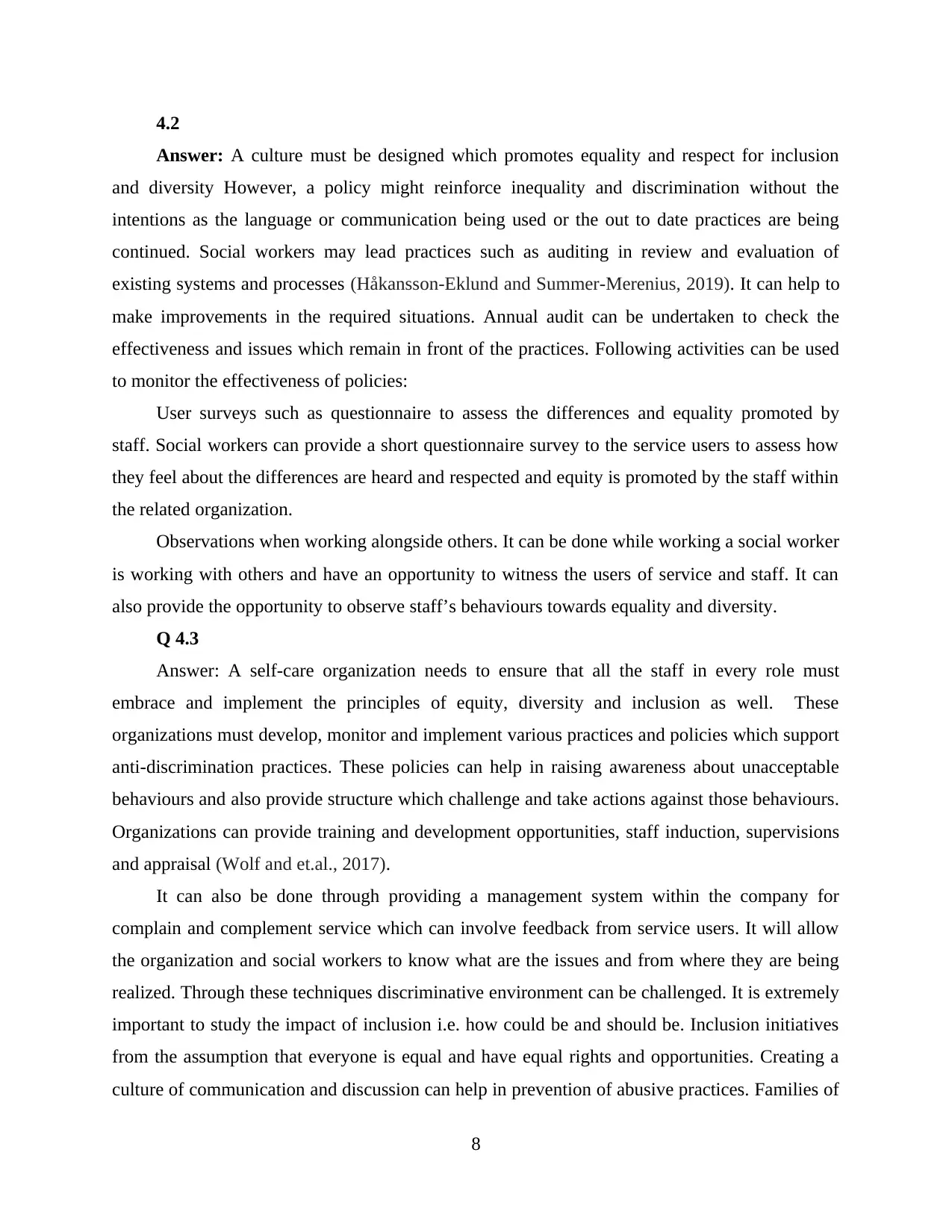
4.2
Answer: A culture must be designed which promotes equality and respect for inclusion
and diversity However, a policy might reinforce inequality and discrimination without the
intentions as the language or communication being used or the out to date practices are being
continued. Social workers may lead practices such as auditing in review and evaluation of
existing systems and processes (Håkansson-Eklund and Summer-Merenius, 2019). It can help to
make improvements in the required situations. Annual audit can be undertaken to check the
effectiveness and issues which remain in front of the practices. Following activities can be used
to monitor the effectiveness of policies:
User surveys such as questionnaire to assess the differences and equality promoted by
staff. Social workers can provide a short questionnaire survey to the service users to assess how
they feel about the differences are heard and respected and equity is promoted by the staff within
the related organization.
Observations when working alongside others. It can be done while working a social worker
is working with others and have an opportunity to witness the users of service and staff. It can
also provide the opportunity to observe staff’s behaviours towards equality and diversity.
Q 4.3
Answer: A self-care organization needs to ensure that all the staff in every role must
embrace and implement the principles of equity, diversity and inclusion as well. These
organizations must develop, monitor and implement various practices and policies which support
anti-discrimination practices. These policies can help in raising awareness about unacceptable
behaviours and also provide structure which challenge and take actions against those behaviours.
Organizations can provide training and development opportunities, staff induction, supervisions
and appraisal (Wolf and et.al., 2017).
It can also be done through providing a management system within the company for
complain and complement service which can involve feedback from service users. It will allow
the organization and social workers to know what are the issues and from where they are being
realized. Through these techniques discriminative environment can be challenged. It is extremely
important to study the impact of inclusion i.e. how could be and should be. Inclusion initiatives
from the assumption that everyone is equal and have equal rights and opportunities. Creating a
culture of communication and discussion can help in prevention of abusive practices. Families of
8
Answer: A culture must be designed which promotes equality and respect for inclusion
and diversity However, a policy might reinforce inequality and discrimination without the
intentions as the language or communication being used or the out to date practices are being
continued. Social workers may lead practices such as auditing in review and evaluation of
existing systems and processes (Håkansson-Eklund and Summer-Merenius, 2019). It can help to
make improvements in the required situations. Annual audit can be undertaken to check the
effectiveness and issues which remain in front of the practices. Following activities can be used
to monitor the effectiveness of policies:
User surveys such as questionnaire to assess the differences and equality promoted by
staff. Social workers can provide a short questionnaire survey to the service users to assess how
they feel about the differences are heard and respected and equity is promoted by the staff within
the related organization.
Observations when working alongside others. It can be done while working a social worker
is working with others and have an opportunity to witness the users of service and staff. It can
also provide the opportunity to observe staff’s behaviours towards equality and diversity.
Q 4.3
Answer: A self-care organization needs to ensure that all the staff in every role must
embrace and implement the principles of equity, diversity and inclusion as well. These
organizations must develop, monitor and implement various practices and policies which support
anti-discrimination practices. These policies can help in raising awareness about unacceptable
behaviours and also provide structure which challenge and take actions against those behaviours.
Organizations can provide training and development opportunities, staff induction, supervisions
and appraisal (Wolf and et.al., 2017).
It can also be done through providing a management system within the company for
complain and complement service which can involve feedback from service users. It will allow
the organization and social workers to know what are the issues and from where they are being
realized. Through these techniques discriminative environment can be challenged. It is extremely
important to study the impact of inclusion i.e. how could be and should be. Inclusion initiatives
from the assumption that everyone is equal and have equal rights and opportunities. Creating a
culture of communication and discussion can help in prevention of abusive practices. Families of
8
⊘ This is a preview!⊘
Do you want full access?
Subscribe today to unlock all pages.

Trusted by 1+ million students worldwide
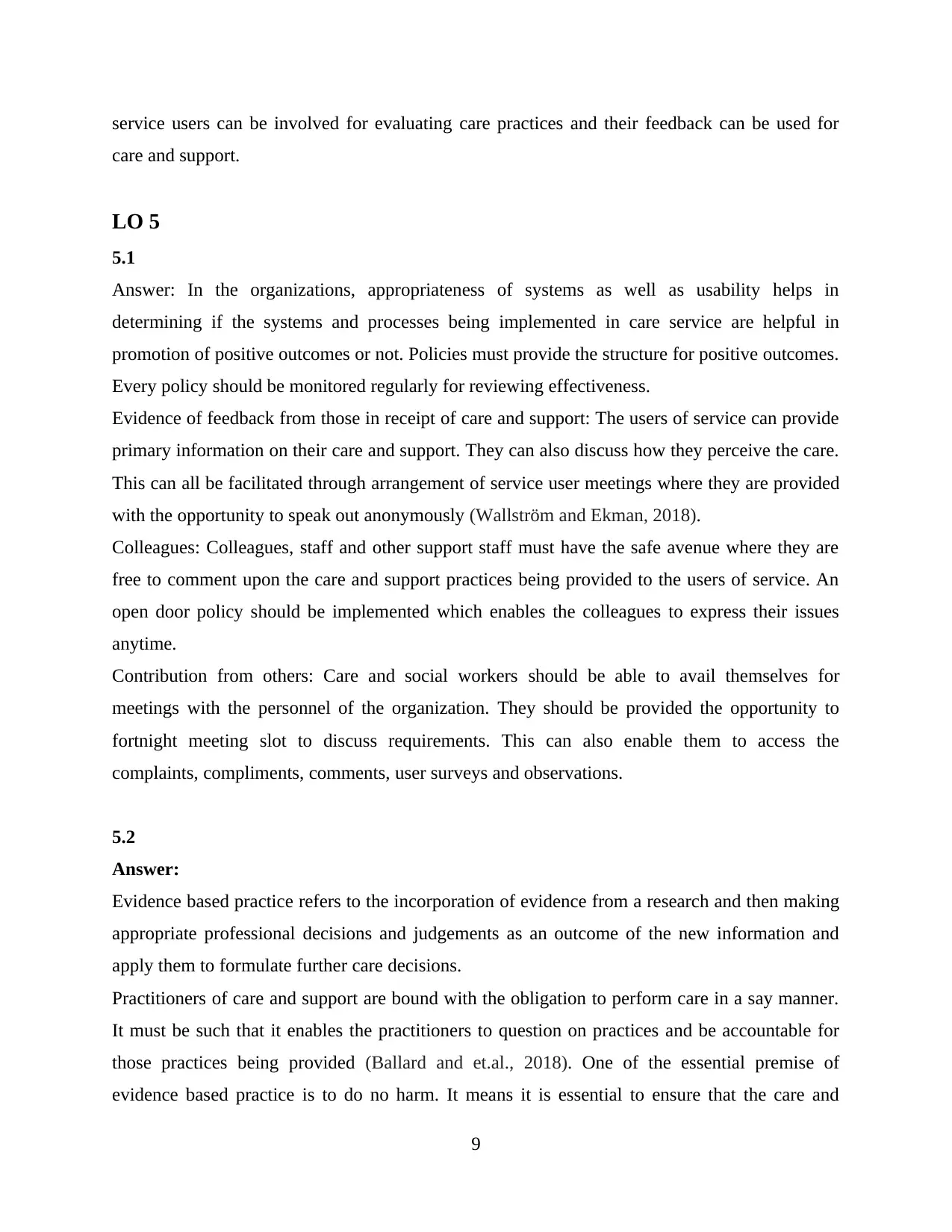
service users can be involved for evaluating care practices and their feedback can be used for
care and support.
LO 5
5.1
Answer: In the organizations, appropriateness of systems as well as usability helps in
determining if the systems and processes being implemented in care service are helpful in
promotion of positive outcomes or not. Policies must provide the structure for positive outcomes.
Every policy should be monitored regularly for reviewing effectiveness.
Evidence of feedback from those in receipt of care and support: The users of service can provide
primary information on their care and support. They can also discuss how they perceive the care.
This can all be facilitated through arrangement of service user meetings where they are provided
with the opportunity to speak out anonymously (Wallström and Ekman, 2018).
Colleagues: Colleagues, staff and other support staff must have the safe avenue where they are
free to comment upon the care and support practices being provided to the users of service. An
open door policy should be implemented which enables the colleagues to express their issues
anytime.
Contribution from others: Care and social workers should be able to avail themselves for
meetings with the personnel of the organization. They should be provided the opportunity to
fortnight meeting slot to discuss requirements. This can also enable them to access the
complaints, compliments, comments, user surveys and observations.
5.2
Answer:
Evidence based practice refers to the incorporation of evidence from a research and then making
appropriate professional decisions and judgements as an outcome of the new information and
apply them to formulate further care decisions.
Practitioners of care and support are bound with the obligation to perform care in a say manner.
It must be such that it enables the practitioners to question on practices and be accountable for
those practices being provided (Ballard and et.al., 2018). One of the essential premise of
evidence based practice is to do no harm. It means it is essential to ensure that the care and
9
care and support.
LO 5
5.1
Answer: In the organizations, appropriateness of systems as well as usability helps in
determining if the systems and processes being implemented in care service are helpful in
promotion of positive outcomes or not. Policies must provide the structure for positive outcomes.
Every policy should be monitored regularly for reviewing effectiveness.
Evidence of feedback from those in receipt of care and support: The users of service can provide
primary information on their care and support. They can also discuss how they perceive the care.
This can all be facilitated through arrangement of service user meetings where they are provided
with the opportunity to speak out anonymously (Wallström and Ekman, 2018).
Colleagues: Colleagues, staff and other support staff must have the safe avenue where they are
free to comment upon the care and support practices being provided to the users of service. An
open door policy should be implemented which enables the colleagues to express their issues
anytime.
Contribution from others: Care and social workers should be able to avail themselves for
meetings with the personnel of the organization. They should be provided the opportunity to
fortnight meeting slot to discuss requirements. This can also enable them to access the
complaints, compliments, comments, user surveys and observations.
5.2
Answer:
Evidence based practice refers to the incorporation of evidence from a research and then making
appropriate professional decisions and judgements as an outcome of the new information and
apply them to formulate further care decisions.
Practitioners of care and support are bound with the obligation to perform care in a say manner.
It must be such that it enables the practitioners to question on practices and be accountable for
those practices being provided (Ballard and et.al., 2018). One of the essential premise of
evidence based practice is to do no harm. It means it is essential to ensure that the care and
9
Paraphrase This Document
Need a fresh take? Get an instant paraphrase of this document with our AI Paraphraser
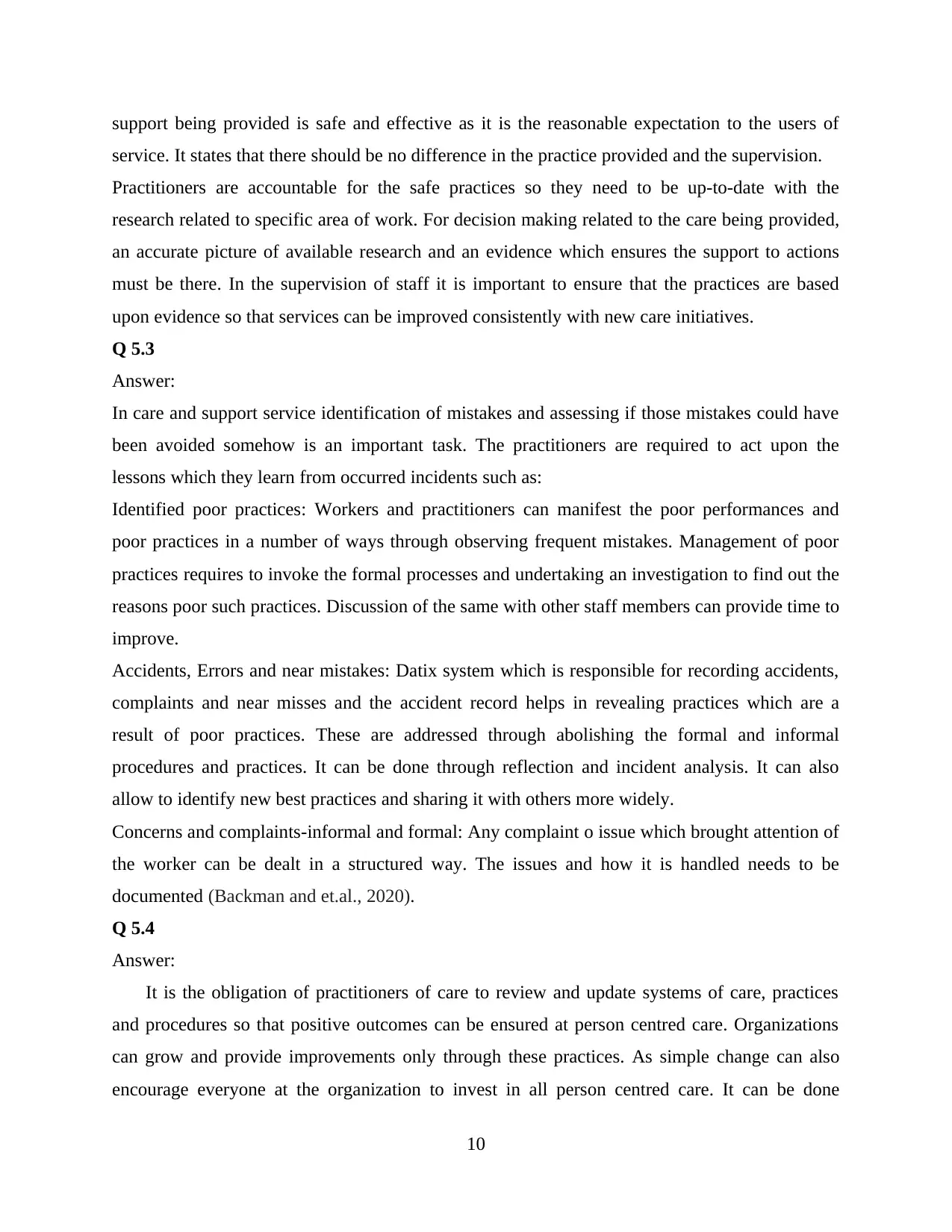
support being provided is safe and effective as it is the reasonable expectation to the users of
service. It states that there should be no difference in the practice provided and the supervision.
Practitioners are accountable for the safe practices so they need to be up-to-date with the
research related to specific area of work. For decision making related to the care being provided,
an accurate picture of available research and an evidence which ensures the support to actions
must be there. In the supervision of staff it is important to ensure that the practices are based
upon evidence so that services can be improved consistently with new care initiatives.
Q 5.3
Answer:
In care and support service identification of mistakes and assessing if those mistakes could have
been avoided somehow is an important task. The practitioners are required to act upon the
lessons which they learn from occurred incidents such as:
Identified poor practices: Workers and practitioners can manifest the poor performances and
poor practices in a number of ways through observing frequent mistakes. Management of poor
practices requires to invoke the formal processes and undertaking an investigation to find out the
reasons poor such practices. Discussion of the same with other staff members can provide time to
improve.
Accidents, Errors and near mistakes: Datix system which is responsible for recording accidents,
complaints and near misses and the accident record helps in revealing practices which are a
result of poor practices. These are addressed through abolishing the formal and informal
procedures and practices. It can be done through reflection and incident analysis. It can also
allow to identify new best practices and sharing it with others more widely.
Concerns and complaints-informal and formal: Any complaint o issue which brought attention of
the worker can be dealt in a structured way. The issues and how it is handled needs to be
documented (Backman and et.al., 2020).
Q 5.4
Answer:
It is the obligation of practitioners of care to review and update systems of care, practices
and procedures so that positive outcomes can be ensured at person centred care. Organizations
can grow and provide improvements only through these practices. As simple change can also
encourage everyone at the organization to invest in all person centred care. It can be done
10
service. It states that there should be no difference in the practice provided and the supervision.
Practitioners are accountable for the safe practices so they need to be up-to-date with the
research related to specific area of work. For decision making related to the care being provided,
an accurate picture of available research and an evidence which ensures the support to actions
must be there. In the supervision of staff it is important to ensure that the practices are based
upon evidence so that services can be improved consistently with new care initiatives.
Q 5.3
Answer:
In care and support service identification of mistakes and assessing if those mistakes could have
been avoided somehow is an important task. The practitioners are required to act upon the
lessons which they learn from occurred incidents such as:
Identified poor practices: Workers and practitioners can manifest the poor performances and
poor practices in a number of ways through observing frequent mistakes. Management of poor
practices requires to invoke the formal processes and undertaking an investigation to find out the
reasons poor such practices. Discussion of the same with other staff members can provide time to
improve.
Accidents, Errors and near mistakes: Datix system which is responsible for recording accidents,
complaints and near misses and the accident record helps in revealing practices which are a
result of poor practices. These are addressed through abolishing the formal and informal
procedures and practices. It can be done through reflection and incident analysis. It can also
allow to identify new best practices and sharing it with others more widely.
Concerns and complaints-informal and formal: Any complaint o issue which brought attention of
the worker can be dealt in a structured way. The issues and how it is handled needs to be
documented (Backman and et.al., 2020).
Q 5.4
Answer:
It is the obligation of practitioners of care to review and update systems of care, practices
and procedures so that positive outcomes can be ensured at person centred care. Organizations
can grow and provide improvements only through these practices. As simple change can also
encourage everyone at the organization to invest in all person centred care. It can be done
10
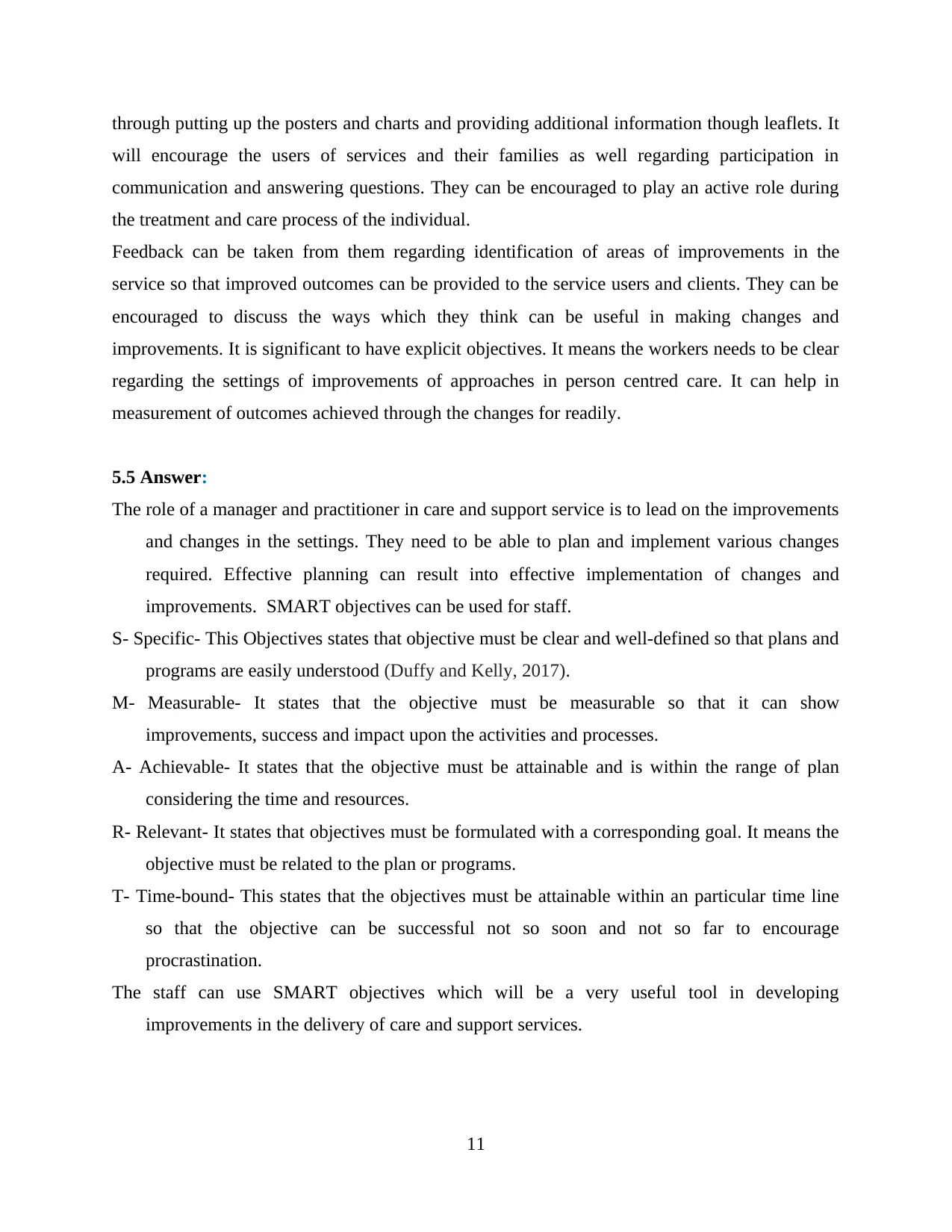
through putting up the posters and charts and providing additional information though leaflets. It
will encourage the users of services and their families as well regarding participation in
communication and answering questions. They can be encouraged to play an active role during
the treatment and care process of the individual.
Feedback can be taken from them regarding identification of areas of improvements in the
service so that improved outcomes can be provided to the service users and clients. They can be
encouraged to discuss the ways which they think can be useful in making changes and
improvements. It is significant to have explicit objectives. It means the workers needs to be clear
regarding the settings of improvements of approaches in person centred care. It can help in
measurement of outcomes achieved through the changes for readily.
5.5 Answer:
The role of a manager and practitioner in care and support service is to lead on the improvements
and changes in the settings. They need to be able to plan and implement various changes
required. Effective planning can result into effective implementation of changes and
improvements. SMART objectives can be used for staff.
S- Specific- This Objectives states that objective must be clear and well-defined so that plans and
programs are easily understood (Duffy and Kelly, 2017).
M- Measurable- It states that the objective must be measurable so that it can show
improvements, success and impact upon the activities and processes.
A- Achievable- It states that the objective must be attainable and is within the range of plan
considering the time and resources.
R- Relevant- It states that objectives must be formulated with a corresponding goal. It means the
objective must be related to the plan or programs.
T- Time-bound- This states that the objectives must be attainable within an particular time line
so that the objective can be successful not so soon and not so far to encourage
procrastination.
The staff can use SMART objectives which will be a very useful tool in developing
improvements in the delivery of care and support services.
11
will encourage the users of services and their families as well regarding participation in
communication and answering questions. They can be encouraged to play an active role during
the treatment and care process of the individual.
Feedback can be taken from them regarding identification of areas of improvements in the
service so that improved outcomes can be provided to the service users and clients. They can be
encouraged to discuss the ways which they think can be useful in making changes and
improvements. It is significant to have explicit objectives. It means the workers needs to be clear
regarding the settings of improvements of approaches in person centred care. It can help in
measurement of outcomes achieved through the changes for readily.
5.5 Answer:
The role of a manager and practitioner in care and support service is to lead on the improvements
and changes in the settings. They need to be able to plan and implement various changes
required. Effective planning can result into effective implementation of changes and
improvements. SMART objectives can be used for staff.
S- Specific- This Objectives states that objective must be clear and well-defined so that plans and
programs are easily understood (Duffy and Kelly, 2017).
M- Measurable- It states that the objective must be measurable so that it can show
improvements, success and impact upon the activities and processes.
A- Achievable- It states that the objective must be attainable and is within the range of plan
considering the time and resources.
R- Relevant- It states that objectives must be formulated with a corresponding goal. It means the
objective must be related to the plan or programs.
T- Time-bound- This states that the objectives must be attainable within an particular time line
so that the objective can be successful not so soon and not so far to encourage
procrastination.
The staff can use SMART objectives which will be a very useful tool in developing
improvements in the delivery of care and support services.
11
⊘ This is a preview!⊘
Do you want full access?
Subscribe today to unlock all pages.

Trusted by 1+ million students worldwide
1 out of 19
Related Documents
Your All-in-One AI-Powered Toolkit for Academic Success.
+13062052269
info@desklib.com
Available 24*7 on WhatsApp / Email
![[object Object]](/_next/static/media/star-bottom.7253800d.svg)
Unlock your academic potential
Copyright © 2020–2025 A2Z Services. All Rights Reserved. Developed and managed by ZUCOL.





